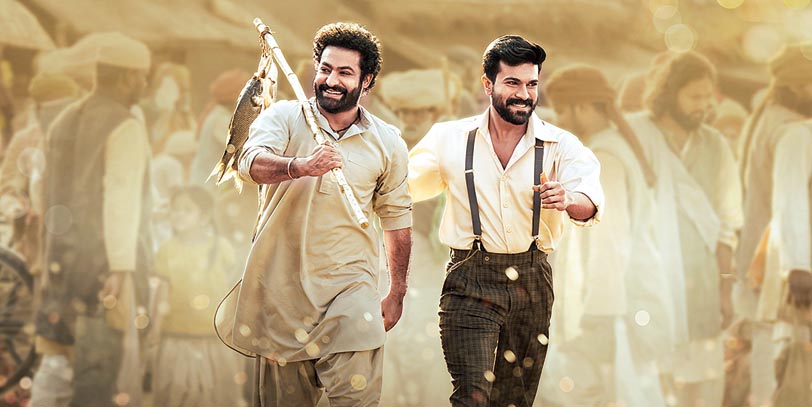Seven years ago, an epic historical, distinguished by spectacular visuals, strong emotional density and a larger-than-life leading man — who played two roles — became one of the biggest blockbusters the country had ever seen. Its follow-up, a few years later, was even bigger, uniting cinema lovers across the north-south-east-west divide.
The Bahubali behemoth not only rewrote the rules of the box office, but also set new benchmarks in scale and storytelling. Quite a few films since then, including some of Bahubali frontman Prabhas’s own big-budget projects, have attempted to build on the foundation of the pan-India bridge laid by Bahubali, but have met with little success, if not complete failure.
Without a shadow of doubt, it has taken another film from the genius of director SS Rajamouli to deliver what definitely is an epic experience at the cinemas, one that breaks cinematic barriers and pushes geographical boundaries. RRR, dare we say, challenging even the most staunch Bahubali fans (one of which is yours truly) not only matches the Bahubali films beat for beat, but sometimes even surpasses them.
‘Roar, Rise, Revolt’ — the film goes by ‘Roudram Ranam Rudhiram’ in Telugu and ‘Rise Roar Revolt’ in Hindi (and well, English) — sums up RRR not only in content, but also form. Rajamouli is a visionary, even a creative revolutionary, whose mind, brain (and heart) travels to places few others can even dare to tread. His film-making, in imagination and inventiveness, constantly pushes the envelope, putting Indian cinema on the global map, one film at a time.
Action set pieces, emotional moments, themes of freedom and friendship, brotherhood and betrayal, revenge and redemption, RRR scores — and scores big — on all levels. This is big-screen cinema at its best. It demands your time, money and attention, and makes sure it’s well worth it.
Like Bahubali, RRR travels into the past. This time it’s the British Raj in the 1920s, and a few decades before that. The film is divided into chapters, the first few to introduce the two men in the centre. History meets fantasy in their origin and characterisation. The historical bit comes from guerilla rebel Alluri Sitarama Raju (aka Rama Raju) and Gond tribe leader Komaram Bheem, both of whom fought the British in their personal capacities. The fantastical and the epical stems from The Ramayana and The Mahabharata that Rajamouli often cites as inspiration and reference. Ram (Ram Charan) and Bheem (Jr NTR) are both fearless men, sharing the common traits of resilience and resourcefulness. Both are driven by a singular goal, but approach it from different ends of the spectrum. Both are opposite forces, described in the film through chapters called ‘Fire’ and ‘Water’ respectively, with the two ultimately colliding at a point. These are seemingly ordinary men whose drive and ambition, individual and collective, makes them perform extraordinary feats. In short, they are the kind of men often seen inhabiting, and leading, the Rajamouli universe.
If one’s entry is an all-immersive scene where he singlehandedly takes on a bloodthirsty mob, then the other roars on to the screen taking on a tiger with his bare hands. Jaw meets floor several times in RRR, with the film, especially in its fantastically mounted and executed action scenes, calling on for more than a suspension of disbelief. You give in to it, willingly and gleefully. Because that’s what the Rajamouli cinema experience demands. The visuals are further enhanced in IMAX and 3D, which is the format I watched the film in.
RRR is a power-packed entertainer, never letting your attention waver for a minute. The story — coming from the pen of Rajamouli’s father KV Vijayendra Prasad — may lack novelty, but the film has enough emotional heft to keep the viewer engaged beyond its arresting visuals. Its strong patriotic flavour and a heartwarming story of friendship, even bordering on bromance, is what lifts RRR from being just another visual spectacle.
Whether it’s the pulsating beats of Nacho nacho, with Ram Charan and Jr NTR, also known as Tarak, showing off some glorious footwork, the daredevil rescue scene in which they meet, and lock hands, for the first time, or ultimately the breathtaking climax where they physically and allegorically embody their trademark traits of fire and water, the two leading men are well matched, shouldering this mammoth film, and possibly taking it a few notches higher than what was on paper. Ram Charan, owing to a more fully formed character arc, has a slight edge over his co-star, rising to the challenge of playing a man who is not always likable.
Ajay Devgn shines in what is an important cameo that provides a new turn to the narrative, but Alia Bhatt, with only a few largely insignificant scenes, has precious little to do. MM Kreem’s music, KK Senthil Kumar’s camerawork and A Sreekar’s Prasad’s deft editing are, however, sureshot winners.
RRR is not without its faults. The extended running time in a world of fast depleting attention span is definitely a downer and some of the Hindi dialogues, in an attempt to translate directly from the Telugu original, end up being too simplistic and literal. But that’s nitpicking in a film that makes the return to the big-screen experience for many after two years a worthwhile outing. ‘Load, Aim, Shoot’ = Blockbuster bullseye.
More about the film
RRR (u/A) 2d/3d
Director: SS Rajamouli
Cast: Ram Charan, Jr NTR, Ajay Devgn, Alia Bhatt, Olivia Morris, Shriya Saran
Running time: 182 minutes











